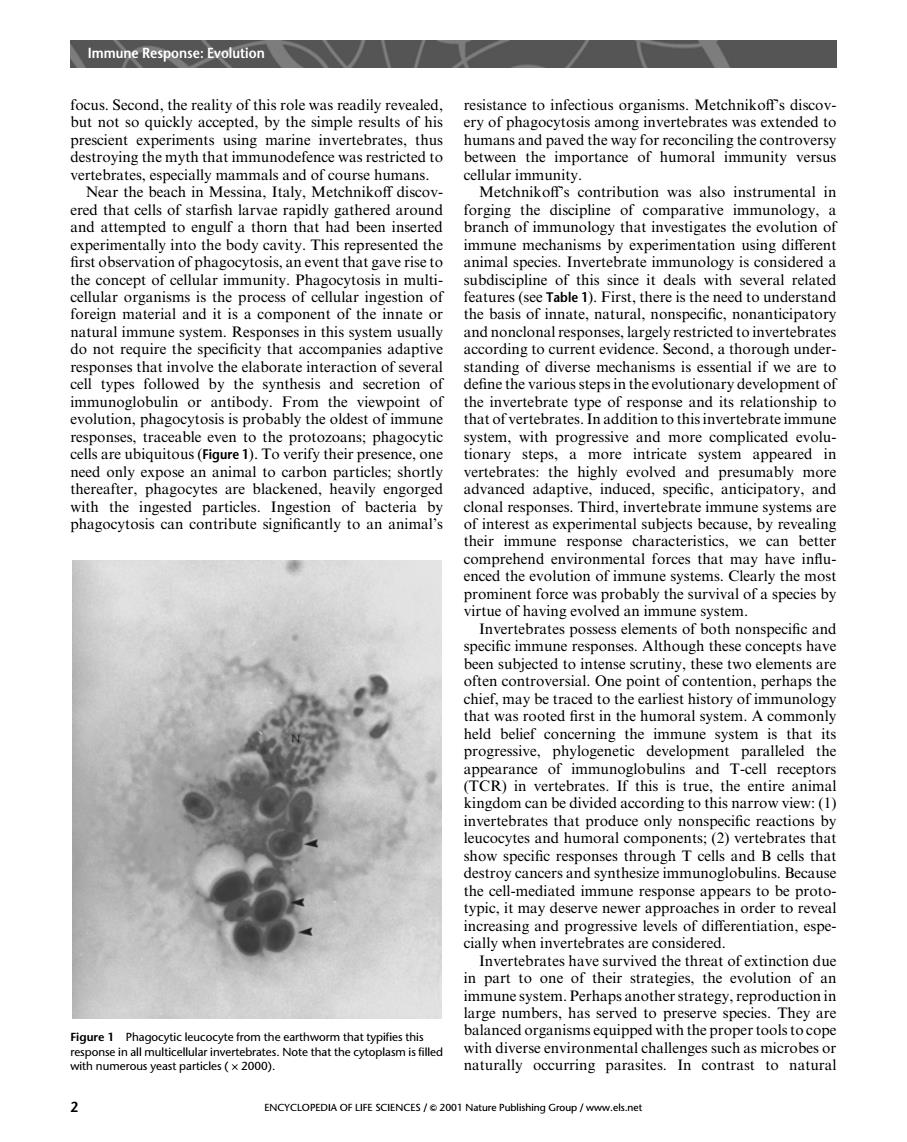正在加载图片...

Immunp Evolution focus.Second.the reality of this role was readily revealed resistance to infectious organisms.Metchnikoff's discov but not so quickly accepted,by the simple results of his ery of phagocytosis among invertebrates was extended to importance munity versus Near the peach in Messina ltaly.Metchniko disc Metchnikofs contribution was also instrumental in ered that cells of starfish larvae rapidly gathered around forging the discipline of comparative immunology.a and attempted to engulf a thorn had been inserted ranch of immunology that investigates the vol the cies.msm the concept of cellular immunity.Phagocytosis in multi ubdiscipline of this since it deals with several related and it a compo innat nnate,natura ally honantic that a nd a th under standing of diverse mechanisms is es sential if we are to cell types followed by the synthesis and secretion of define the various steps in the evolutionary development o the tionary steps a more intricate system appeared in need only expose an anima umably mor an the phagocytes are y engorge adap Third spec anticipatory, their immune response characteristics.we can beuter the Invertebrates possess elements of both nonspecific and specific immune responses.Although these con cepts have the chief.m po arliest histor that was rooted first in the humoral system.A commonly phylogene de opm ulin is tr the ntir m kingdom can be divided according to this narrow view:(1) cocyte comp the cell-mediated immune response appears to be proto- typic,it may deserve newer approach in order to reveal sive levels fferentiation,espe- Invertebrates have survived the thre at of extinction due in part to one of their strategies,the evolution of an arge nu has serve to pr th ey are with diverse environmental challenge such as microbes o naturally occurring parasites.In contrast to natural 1 ENCYCLOPEDIA OF LIFE SCIENCES/e2001 Na www.els.netfocus. Second, the reality of this role was readily revealed, but not so quickly accepted, by the simple results of his prescient experiments using marine invertebrates, thus destroying the myth that immunodefence was restricted to vertebrates, especially mammals and of course humans. Near the beach in Messina, Italy, Metchnikoff discovered that cells of starfish larvae rapidly gathered around and attempted to engulf a thorn that had been inserted experimentally into the body cavity. This represented the first observation of phagocytosis, an event that gave rise to the concept of cellular immunity. Phagocytosis in multicellular organisms is the process of cellular ingestion of foreign material and it is a component of the innate or natural immune system. Responses in this system usually do not require the specificity that accompanies adaptive responses that involve the elaborate interaction of several cell types followed by the synthesis and secretion of immunoglobulin or antibody. From the viewpoint of evolution, phagocytosis is probably the oldest of immune responses, traceable even to the protozoans; phagocytic cells are ubiquitous (Figure 1). To verify their presence, one need only expose an animal to carbon particles; shortly thereafter, phagocytes are blackened, heavily engorged with the ingested particles. Ingestion of bacteria by phagocytosis can contribute significantly to an animal’s resistance to infectious organisms. Metchnikoff’s discovery of phagocytosis among invertebrates was extended to humans and paved the way for reconciling the controversy between the importance of humoral immunity versus cellular immunity. Metchnikoff’s contribution was also instrumental in forging the discipline of comparative immunology, a branch of immunology that investigates the evolution of immune mechanisms by experimentation using different animal species. Invertebrate immunology is considered a subdiscipline of this since it deals with several related features (see Table 1). First, there is the need to understand the basis of innate, natural, nonspecific, nonanticipatory and nonclonal responses, largely restricted to invertebrates according to current evidence. Second, a thorough understanding of diverse mechanisms is essential if we are to define the various steps in the evolutionary development of the invertebrate type of response and its relationship to that of vertebrates. In addition to this invertebrate immune system, with progressive and more complicated evolutionary steps, a more intricate system appeared in vertebrates: the highly evolved and presumably more advanced adaptive, induced, specific, anticipatory, and clonal responses. Third, invertebrate immune systems are of interest as experimental subjects because, by revealing their immune response characteristics, we can better comprehend environmental forces that may have influenced the evolution of immune systems. Clearly the most prominent force was probably the survival of a species by virtue of having evolved an immune system. Invertebrates possess elements of both nonspecific and specific immune responses. Although these concepts have been subjected to intense scrutiny, these two elements are often controversial. One point of contention, perhaps the chief, may be traced to the earliest history of immunology that was rooted first in the humoral system. A commonly held belief concerning the immune system is that its progressive, phylogenetic development paralleled the appearance of immunoglobulins and T-cell receptors (TCR) in vertebrates. If this is true, the entire animal kingdom can be divided according to this narrow view: (1) invertebrates that produce only nonspecific reactions by leucocytes and humoral components; (2) vertebrates that show specific responses through T cells and B cells that destroy cancers and synthesize immunoglobulins. Because the cell-mediated immune response appears to be prototypic, it may deserve newer approaches in order to reveal increasing and progressive levels of differentiation, especially when invertebrates are considered. Invertebrates have survived the threat of extinction due in part to one of their strategies, the evolution of an immune system. Perhaps another strategy, reproduction in large numbers, has served to preserve species. They are balanced organisms equipped with the proper tools to cope with diverse environmental challenges such as microbes or naturally occurring parasites. In contrast to natural Figure 1 Phagocytic leucocyte from the earthworm that typifies this response in all multicellular invertebrates. Note that the cytoplasm is filled with numerous yeast particles ( 2000). Immune Response: Evolution 2 ENCYCLOPEDIA OF LIFE SCIENCES / & 2001 Nature Publishing Group / www.els.net